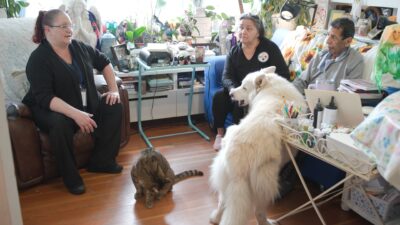Like adults, children and adolescents face losses and experience grief. Loved ones die — grandparents, parents, siblings, and friends. The death of a beloved pet is often a child’s first experience with death.
Other losses that do not involve death, such as divorce, family relocation, or a friend moving away, also may generate grief. As children move into adolescence, they may grieve other less obvious losses, such as loss of identity, loss of roles at home or school, or loss of self-esteem.
Children respond to loss as adults do: physically, emotionally, psychologically, behaviorally, and spiritually. And like adults, every child — even those in the same family grieving the same death — will grieve in their own way.
Although children see death depicted on television, in video games, and even in nursery rhymes, death and dying are rarely discussed openly in our culture. As a result, it may seem daunting to talk about death with a child. Read answers to frequently asked questions about children, adolescents, and grief.
Ways to help grieving children
There are many ways to support a grieving child or teen. Here some suggestions, but it is important to remember that everyone experiences grief in their own way. One approach might be helpful for one child but not for another.
- Bereavement support groups. Group support can be an effective way for school-age children to process their grief. Children don’t want to be different from their peers; by participating with other children who have experienced loss, they find they are not alone.
- Art and other expressive approaches. Artistic expression can be great way to help children identify their feelings of grief. Activities might include painting a picture of their feelings; writing and drawing in a journal; making up a song about their loved one; reading books or watching movies that open discussions of death and loss; making a list of what makes them angry, sad, grateful, afraid, frustrated, or happy.
- Children’s grief groups and camps. Many hospices offer support groups and camps specifically designed to help children and adolescents cope with grief. Some communities have a dedicated children’s grief center or organization. Participation with other bereaved peers, especially for teens, can make a grieving young person feel less isolated and alone.
Additional Resources
Actively Moving Forward
Actively Moving Forward® (AMF), a HealGrief® program, is a national network created in response to the needs of young adults who are grieving. It connects, supports, and empowers bereaved young adults to “actively move forward” in memory of the person they lost.
Children’s Bereavement Center
The Children’s Bereavement Center and its adult division, Lift From Loss®, provide free peer support groups for children, young adults, and adults after the death of a loved one. Groups are open to anyone who has lost a parent, sibling, grandparent, relative, or friend as a result of illness, accident, suicide, or homicide.
The Compassionate Friends
The Compassionate Friends provides highly personal comfort, hope, and support to families that have experienced the death of a child, grandchild, or sibling, and it helps others better assist the grieving family.
Dougy Center
The Dougy Center provides grief support in a safe place where children, teens, young adults, and their families can share their experiences before and after a death. It provides resources, support and training locally, nationally, and internationally to individuals and organizations seeking to assist children who are grieving.
National Alliance for Children’s Grief
The National Alliance for Children’s Grief (NACG) raises awareness about the needs of children and teens who are grieving a death and provides education and resources to anyone who wants to support them.
TAPS
TAPS offers support programs for children and teens who are grieving the death of a military family member. Led by caring professionals in the fields of child development, grief support, mental health, and education, TAPS youth programs provide safe spaces for military children to be supported in their grief while also experiencing fun, adventure, mentorship, and camaraderie.


